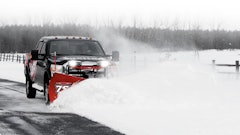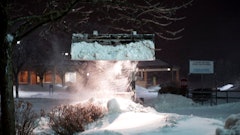This winter for the United States has been one for the snow record books, and in many parts of the nation, snowblowers continue their workouts.
According to the experts at Honda Power Equipment, marketer of a complete line of power equipment – including snowblowers – preventive maintenance goes a long way to keep your snowblower in top operational form. Honda offers these operational and maintenance tips as you use your snowblower during the remainder of the season:
- Check the snowblower’s engine oil levels daily.
- Check the machine’s main wear items – these include the blower’s skid shoes and the scraper bar; both are intended to rub along the ground as the unit is operated and can wear out even faster if you’re trying to clear snow down to the bare pavement.
NOTE: Both the skid shoes and the scraper bar are, on many popular models, usually held in place by nuts and bolts. Operators should follow the following steps for adjustment and replacement (but make sure the machine is not running while checking everything out):
- Place the snowblower on a level surface. For track-type snowblowers, step on the foot pedal, and set the auger – the device that collects and throws the snow – in the middle position.
- Loosen the skid shoe nuts and obtain the auger ground clearance for the appropriate snow conditions. Adjust the right and left shoes equally, and then retighten the nuts securely.
- Loosen all the nuts, holding the scraper, and adjust the scraper to the specified ground clearance. Be sure to retighten the nuts securely.
- Inspect the scraper and replace it if it is excessively worn.
Operational trouble?
- A lack of power may indicate the need for a tune up where spark plugs are replaced and valves are adjusted.
- Black smoke coming out of the exhaust may indicate a “rich” condition – a common problem when operating at high-altitudes (above 5,000 feet). Here, your authorized dealer may suggest resetting the carburetor.
- For oil changes, tune-up intervals, information about replacement parts, and warranty information refer to the owner’s manual specific to your own model.
Planning Ahead: Snowblower Storage 101
When the snow finally does begin to melt, and thoughts turn to landscaping and backyard barbeques, snowblower owners will need to prepare their models for hibernation. The experts at Honda Power Equipment offer several good storage practices for snowblowers that help to ensure optimum performance and a long working life for these winter weather powerhouses:
- Because rust and corrosion will keep a snowblower from operating at peak performance, clean the auger housing with water and wipe down with a cloth before storing.
- Check the chute drive gear, shift and throttle levers, and ring gear; if any lubrication is necessary, do so before storing.
- As with any gas powered power equipment model, empty a snowblower’s fuel tank or add fuel stabilizer before storing a snowblower for any length of time. This will make for an easy start on the next pull.
- Check for any worn parts and order from the dealer as it is easier to replace what is needed ahead of next year’s first snowfall.
- Check manufacturers service manuals for suggested maintenance schedules and keep good records for all equipment.
- Inspect all painted surfaces and touch up where needed.
For more information, visit Honda’s Website.
![Kubota Snow ah3 Sgv25ua[1]](https://img.greenindustrypros.com/mindful/acbm/workspaces/default/uploads/2025/10/kubota-snowah3sgv25ua1.bAUoUSziui.png?auto=format%2Ccompress&bg=fff&fill-color=fff&fit=fill&h=100&q=70&w=100)







![Kubota Snow ah3 Sgv25ua[1]](https://img.greenindustrypros.com/mindful/acbm/workspaces/default/uploads/2025/10/kubota-snowah3sgv25ua1.bAUoUSziui.png?ar=16%3A9&auto=format%2Ccompress&bg=fff&fill-color=fff&fit=fill&h=135&q=70&w=240)










